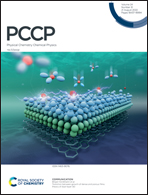Application of machine-learning-based global optimization: potential-dependent co-electrosorbed structure and activity on the Pd(110) surface†
Abstract
Electrodes can adsorb different reaction intermediates under electrochemical conditions, which in turn significantly affect their electrochemical performance. This complex phenomenon attracts continuous interest in both science and industry for understanding the co-electrosorbed structure and activity under electrochemical conditions. Here, we report the first theoretical attempt by combining the machine-learning-based global optimization (SSW-NN method) and modified Poisson–Boltzmann continuum solvation (CM-MPB) based on first-principles calculations to elucidate the potential-dependent co-electrosorbed species on the Pd(110) surface. We reveal the potential-dependence adsorption/absorption hydrogen phases, the phase transition of α-Hri/Pd to β-Hri/Pd, and the co-electrosorbed Hri-NHy surface structures. In particular, we found that Hri-NH2 and Hri-NH3 are favorable intermediates for the N2 reduction reaction, and the subsurface H is the key species responsible for NH2 hydrogenation on the Pd(110) electrode.

- This article is part of the themed collection: 2022 PCCP HOT Articles


 Please wait while we load your content...
Please wait while we load your content...